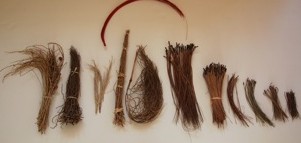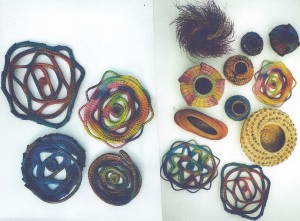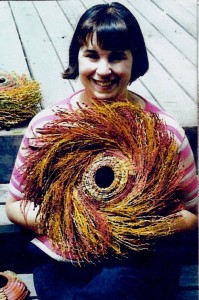Kathy Krebs has been coiling baskets and vessels made principally of pine needles for over 25 years. According to Kathy, one of the great joys of coiling from nature has been the foraging for materials.
Kathy started her weaving journey on a four harness loom. Her initial interest was rug weaving and, in an effort to learn as much as possible and to see other artists’ works, she visited many galleries featuring fiber art. At one of these galleries she became aware of the Torrey Pine needle baskets made by Neil and Fran Kraynek-Prince, artists long associated with the American Craft Council. She was intrigued by the fact that their vessels were created from locally gathered pine needles and they had transformed basketry into art. At the time, the above mentioned artists as well as Clay Burnette of the Carolinas were the few that she discovered using pine needles to construct large, sculptural pieces.
Kathy was hooked! She began gathering pine needles and experimenting with coiling. She collected Torrey Pine needles, which are long and thick, for her largest vessels. These are found mostly in coastal San Diego County where Kathy foraged along the edges of the Torrey Pines Golf Course and beneath trees growing on the UC San Diego campus. Kathy soon began collecting and experimenting with the needles of other types of pines that grow in California. The long needles of the Jeffrey Pine with its pineapple-vanilla scented bark, the thick, 12″ needles of the Coulter Pine, the droopy 10″ pinestraw of the Digger and the 7″ needles of the Sugar Pine. She has also found fragrant falls of 6″ Bishop Pine needles in coastal areas and Canary Island Pine needles, fine, silky, long and great for smaller pieces, under plantings in shopping malls and residential gardens.

Kathy Kreb's materials
She also gathered the fruiting stalks from Coachella Valley date plantations a well as from the Washingtonia palm, a California native that grows along the roadside there.
When Kathy is foraging, she chooses the topmost fall of needles beneath their trees, choosing those that are dry, uniform in color and free from mold. She soaks the collected materials in warm water with a diluted disinfecting agent such as Pine-sol. She then drains off the solution, blots up excess moisture and spreads them out on her deck to dry. If the needles are green, she dries them in a dark place in order to preserve their color. When the needles are dry, Kathy stores them in bundles in plastic bins.
Color is obviously an important component in her vessels. Kathy was inspired by the color palette of nature to experiment with dyeing the pine needles. She has experimented with many dyes, but generally ends up with Rit, using at least twice the strength recommended for cloth. She also has used an acrylic wash over the needles to enhance the color.
When working with the needles, Kathy soaks them first to make them pliable and coils with damp, not wet, needles. Fresh, green needles should never be used for coiling as the basket will shrink and loosen.

Baskets by Kathy Krebs
When Kathy first started experimenting with pine needle baskets, what appealed to her was that the materials were abundant and free and that the work was portable. She had a small child at the time, so those things were important. To advance her knowledge and skill, she took classes, read about basketry and honed her talent. She soon was giving workshops in high schools, colleges and art centers as well as selling her baskets to art galleries, museum shops and retail stores. She exhibited in American Craft Council shows and contacts made through that venue has led to corporate clients and several commissions.
Kathy has recently retired from her full time fiber art business. Now, instead of working 8-10 hours a day to fill her orders, she works for short stints on small twined pieces. Regarding her many years of working with pine needles she says, ” I have loved the proximity with the beauties of nature in foraging and collecting materials for my baskets and vessels, and the great satisfaction of incorporating nature’s fallen bounty into works of art.”

Kathy Krebs and one of her vessels